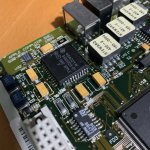LazarusNine
Well-known member
I can’t remember the issue with this board - it may function fine, actually. It’s been fully recapped and cleaned. However, there’s quite a lot of corrosion at the base of the TI chip shown in the centre of the photo. It looks like the corrosion may even be bridging a couple leads. I’ve tried the typical techniques of removing it: 1) scrubbing 99% isopropyl alcohol with a toothbrush; 2) targeted scrubbing with acetone. The whole board has been through the dishwasher as well. I’ve read that baking soda might work, but I’ve not yet tried it. Does anyone have any suggestions how I can tackle this? Thanks!


